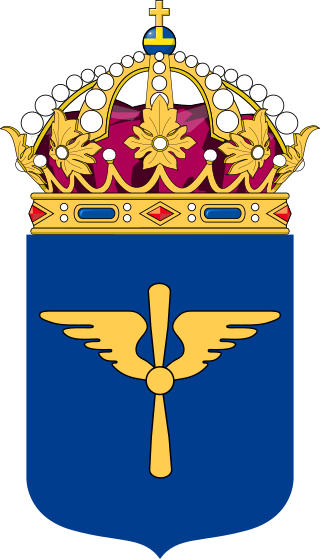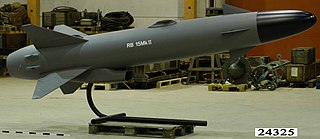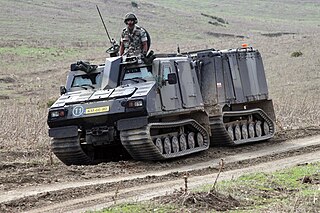Related Research Articles

The Saab JAS 39 Gripen is a light single-engine supersonic multirole fighter aircraft manufactured by the Swedish aerospace and defence company Saab AB. The Gripen has a delta wing and canard configuration with relaxed stability design and fly-by-wire flight controls. Later aircraft are fully NATO interoperable. As of 2020, more than 271 Gripens of all models, A–F, have been delivered.

The Combat Vehicle 90 (CV90) is a family of Swedish tracked armoured combat vehicles designed by the Swedish Defence Materiel Administration (FMV), Hägglund & Söner and Bofors during the mid-1980s to early 1990s, before entering service in Sweden in the mid-1990s. The CV90 platform design has continuously evolved from the Mk 0 to the current Mk IV with technological advances and changing battlefield requirements.

The Visby class is a series of corvettes in use by the Swedish Navy. It is the latest class of corvette adopted by the navy after the Göteborg and Stockholm-class corvettes. Its design emphasizes low visibility radar cross-section and infrared signature, and the class has received widespread international attention because of its capabilities as a stealth ship. The first ship in the class is named after Visby, the main city on the island of Gotland.

The Swedish Air Force is the air force branch of the Swedish Armed Forces.

The NHIndustries NH90 is a European medium-sized, twin-engine, multirole military helicopter. It was the first production helicopter to feature entirely fly-by-wire flight controls.

The Halifax-class frigate, also referred to as the City class, is a class of multi-role patrol frigates that have served the Royal Canadian Navy since 1992. The class is the outcome of the Canadian Patrol Frigate Project, which dates to the mid-1970s. HMCS Halifax was the first of an eventual twelve Canadian-designed and Canadian-built vessels which combine traditional anti-submarine capabilities with systems to deal with surface and air threats as well. Ships of the class are named after capital cities of Canadian provinces, the capital of Canada, Ottawa, and the major cities of Calgary, Montreal, and Vancouver.

The Saab Bofors Dynamics NLAW, also known as the MBT LAW or RB 57, is a fire-and-forget, lightweight shoulder-fired, and disposable (single-use) line of sight (LOS) missile system, designed for infantry use. The missile uses a soft-launch system and is guided by predicted line of sight (PLOS). It can carry out an overfly top attack (OTA) on an armoured vehicle, or a direct attack (DA) on structures and non-armoured vehicles.

Saab Kockums AB is a shipyard headquartered in Malmö, Sweden, owned by the Swedish defence company Saab Group. Saab Kockums AB is further operational in Muskö, Docksta, and Karlskrona. While having a history of civil vessel construction, Kockums' most renowned activity is the fabrication of military corvettes and submarines.

HSwMS Gotland (Gtd) is a defense submarine of the Swedish Navy. It was the first ship of the Gotland-class, which was the first operational submarine class in the world to use air-independent propulsion in the form of Stirling engines which use liquid oxygen and diesel as the propellant.

The Gotland-class submarines of the Swedish Navy are modern diesel-electric submarines, which were designed and built by the Kockums shipyard in Sweden. They are the first submarines in the world to feature a Stirling engine air-independent propulsion (AIP) system, which extends their underwater endurance from a few days to weeks. This capability had previously only been available with nuclear-powered submarines.

The RBS 15 is a long-range fire-and-forget surface-to-surface and air-to-surface anti-ship missile. The later version Mk. IV has the ability to attack land targets as well. The missile was developed by the Swedish company Saab Bofors Dynamics.

The BvS10 is a tracked articulated amphibious all-terrain armoured vehicle produced by BAE Systems Land Systems Hägglunds of Sweden. This vehicle, referred to as the All Terrain Vehicle (protected) - ATV(P) or Viking by the UK forces, was originally developed as a collaboration between industry - Hägglunds Vehicle AB - and the British Ministry of Defence (MoD) on behalf of the Royal Marines.
The Blekinge-class submarine is the next generation of submarines developed by Kockums for the Swedish Navy, also known as the A26 type.

The Saab 340 AEW&C is a Swedish airborne early warning and control (AEW&C) aircraft. A variant of the Saab 340 aircraft is designated S 100B Argus by the Swedish Air Force.

GlobalEye is a multi-role airborne early warning & control (AEW&C) platform from Swedish defence and security company Saab. GlobalEye consists of a suite of sensors using Saab's Erieye ER radar and mission system, installed in the Bombardier Global 6000/6500 long-range business jet.
The Torped 47 or SLWT is a new lightweight torpedo intended for ASW and surface targets, providing multiple-target active/passive homing combined with wire guidance. It is designed and manufactured by Saab Dynamics as a replacement for the Torped 45.
HSwMS Artemis is a signals intelligence gathering vessel currently in service for the Swedish Navy.

HSwMS Gävle (K22) is a Swedish Navy Göteborg-class corvette, named after the Swedish city of Gävle.
The Brazilian Navy has a large number of active and planned projects, under the modernization plans of the Brazilian Armed Forces, defined in the National Defense White Paper. From 2010, Brazil started a radical change in its military policy, aiming to consolidate itself as the major power of Latin America, then the country's military strategists saw the great importance in modernize the Navy, both in terms of global projection and deterrence against possible threats to national interests by foreign powers from the year 2040, the total estimated budget for the plan was estimated in US$ 119 billion in 2010.
References
- ↑ Archived February 28, 2009, at the Wayback Machine
- ↑ Archived November 3, 2006, at the Wayback Machine
- ↑ Archived October 16, 2012, at the Wayback Machine
- ↑ "Saab Receives Order for Torpedo 62 Life Extension". Start. Retrieved 2024-07-03.
- ↑ "Saab Receives Further Order on Heavyweight Torpedo System". Start. Retrieved 2024-07-03.